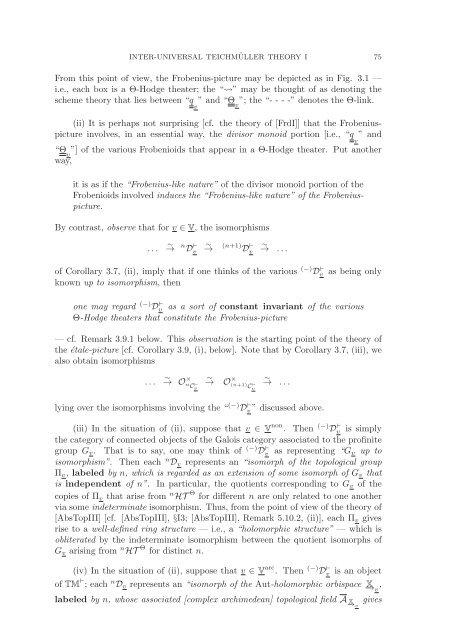Inter-universal Teichmuller Theory I: Construction of Hodge Theaters
Inter-universal Teichmuller Theory I: Construction of Hodge Theaters
Inter-universal Teichmuller Theory I: Construction of Hodge Theaters
You also want an ePaper? Increase the reach of your titles
YUMPU automatically turns print PDFs into web optimized ePapers that Google loves.
INTER-UNIVERSAL TEICHMÜLLER THEORY I 75<br />
From this point <strong>of</strong> view, the Frobenius-picture may be depicted as in Fig. 3.1 —<br />
i.e., each box is a Θ-<strong>Hodge</strong> theater; the “” may be thought <strong>of</strong> as denoting the<br />
scheme theory that lies between “q<br />
v<br />
”and“Θ v<br />
”; the “- - - -” denotes the Θ-link.<br />
(ii) It is perhaps not surprising [cf. the theory <strong>of</strong> [FrdI]] that the Frobeniuspicture<br />
involves, in an essential way, the divisor monoid portion [i.e., “q ”and<br />
v<br />
“Θ v<br />
”] <strong>of</strong> the various Frobenioids that appear in a Θ-<strong>Hodge</strong> theater. Put another<br />
way,<br />
it is as if the “Frobenius-like nature” <strong>of</strong> the divisor monoid portion <strong>of</strong> the<br />
Frobenioids involved induces the “Frobenius-like nature” <strong>of</strong> the Frobeniuspicture.<br />
By contrast, observe that for v ∈ V, the isomorphisms<br />
...<br />
∼<br />
→ n D ⊢ v<br />
∼<br />
→<br />
(n+1) D ⊢ v<br />
∼<br />
→ ...<br />
<strong>of</strong> Corollary 3.7, (ii), imply that if one thinks <strong>of</strong> the various (−) Dv<br />
⊢<br />
known up to isomorphism, then<br />
as being only<br />
one may regard (−) Dv<br />
⊢ as a sort <strong>of</strong> constant invariant <strong>of</strong> the various<br />
Θ-<strong>Hodge</strong> theaters that constitute the Frobenius-picture<br />
— cf. Remark 3.9.1 below. This observation is the starting point <strong>of</strong> the theory <strong>of</strong><br />
the étale-picture [cf. Corollary 3.9, (i), below]. Note that by Corollary 3.7, (iii), we<br />
also obtain isomorphisms<br />
...<br />
∼<br />
→ O ×n C ⊢ v<br />
∼<br />
→<br />
O × (n+1) C ⊢ v<br />
∼<br />
→ ...<br />
lying over the isomorphisms involving the “ (−) D ⊢ v ” discussed above.<br />
(iii) In the situation <strong>of</strong> (ii), suppose that v ∈ V non . Then (−) Dv ⊢ is simply<br />
the category <strong>of</strong> connected objects <strong>of</strong> the Galois category associated to the pr<strong>of</strong>inite<br />
group G v . That is to say, one may think <strong>of</strong> (−) Dv ⊢ as representing “G v up to<br />
isomorphism”. Then each n D v represents an “isomorph <strong>of</strong> the topological group<br />
Π v , labeled by n, which is regarded as an extension <strong>of</strong> some isomorph <strong>of</strong> G v that<br />
is independent <strong>of</strong> n”. In particular, the quotients corresponding to G v <strong>of</strong> the<br />
copies <strong>of</strong> Π v that arise from n HT Θ for different n are only related to one another<br />
via some indeterminate isomorphism. Thus, from the point <strong>of</strong> view <strong>of</strong> the theory <strong>of</strong><br />
[AbsTopIII] [cf. [AbsTopIII], §I3; [AbsTopIII], Remark 5.10.2, (ii)], each Π v gives<br />
rise to a well-defined ring structure — i.e., a “holomorphic structure” —whichis<br />
obliterated by the indeterminate isomorphism between the quotient isomorphs <strong>of</strong><br />
G v arising from n HT Θ for distinct n.<br />
(iv) In the situation <strong>of</strong> (ii), suppose that v ∈ V arc . Then (−) Dv<br />
⊢ is an object<br />
<strong>of</strong> TM ⊢ ; each n D v represents an “isomorph <strong>of</strong> the Aut-holomorphic orbispace −→v X ,<br />
labeled by n, whose associated [complex archimedean] topological field A X−→v gives
















